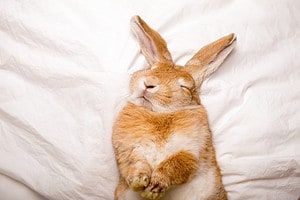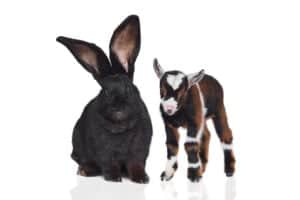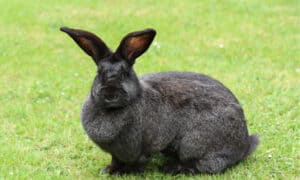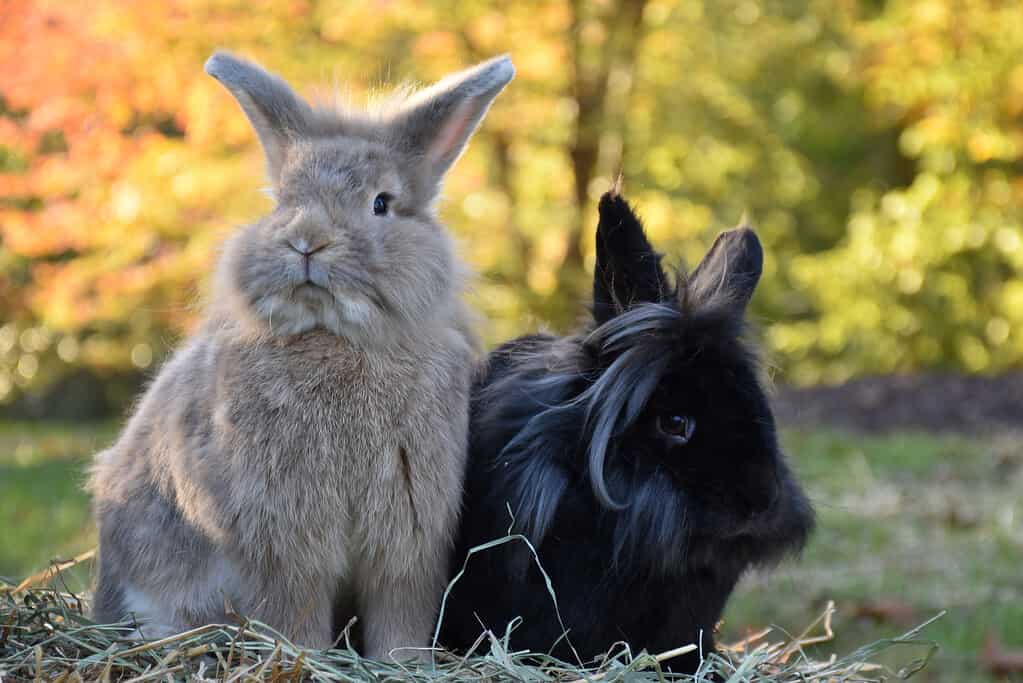
Rabbits are adorable and fluffy, but all that fur means they are prone to heavy shedding.
©JudyN/iStock via Getty Images
Do you have a rabbit that’s shedding excessively? While rabbits naturally shed and lose quite a bit of fur throughout the year, there are times when the loss is much worse than normal. Not only is it annoying to deal with that much fur all over your home, but it may mean something is wrong with your precious pet. To learn more about what might make a rabbit shed more than normal and how to fix it, continue reading below.
Introduction: Understanding Excessive Rabbit Shedding and Its Causes
Rabbits shed a lot. Even when it isn’t molting season, rabbits will lose fur all the time. You and your vacuum will be constant companions after getting a bunny as a pet.
There are times when shedding is excessive. Certain health conditions, stress, boredom, and even your lighting can lead to your rabbit losing fur at a high rate.
The easiest way to tell if a rabbit is shedding normally or excessively is the way the fur is lost. If your rabbit has a lot of bald patches as it sheds, the fur looks unhealthy and thick, or your rabbit is getting rashes and sores where they are losing fur, that’s a good sign that something is wrong.
Shedding Seasons: Exploring the Natural Shedding Cycles of Rabbits
Naturally, rabbits shed twice a year. As the weather gets cooler in the fall, they will shed some of their shorter, thinner fur to make room for a thicker coat. In the spring, rabbits will shed their thicker fur for a more comfortable summer coat.
When a rabbit sheds, they generally start from the head and face area. As the molt goes on, it will slowly creep down its back until it reaches its tail. There’s also often a distinct line between the old coat and the new one.
Outdoor Rabbits
If you keep your rabbits outside in a hutch all year round, twice-yearly shedding is what you can expect to see. The shedding season tends to last somewhere between two and six weeks each time.
Rabbits that Go Inside and Outside
For rabbits that transition between indoors and outdoors frequently, they may have several mini sheds a year, instead of two as the different temperatures mess with their natural cycles.
Indoor Rabbits
Since rabbits kept indoors do not experience the changing seasons, they do not often have specific shedding seasons. Instead, they shed regularly throughout the year.
Baby Rabbits
Baby rabbits shed a little differently than adult rabbits. Young rabbits have a soft and extra fluffy coat until they are around five or six months old. They don’t usually shed a lot during this period.
Even after six months, the coat goes from what is known as a transitional coat to its adult coat. The adult coat comes fully after about a year. Only after that year should young rabbits start to show signs of regular shedding.
Underlying Factors: Identifying Health Issues and Stressors that Can Cause Excessive Shedding

If your rabbit is stressed or sick, they may lose their fur more than normal.
©Choco’Love/Shutterstock.com
There are a few ways to tell if your rabbit is shedding more than normal. If your rabbit is losing fur at an alarming rate, they may start to show signs of balding. The fur will likely fall out in patches, which means that some parts of your rabbit’s coat will be thinner or missing. Certain conditions may have your rabbit balding or losing fur in specific places.
Below are some of the common reasons rabbits may start shedding excessively. If your rabbit is showing signs of irritated bald patches, crusty skin, dandruff, or seems to be very itchy, alongside their shedding, it may be a sign that something isn’t normal.
Inbreeding
Some rabbits that have suffered from inbreeding tend to shed more often than a normal rabbit. Their genetic makeup leads them to not respond properly to light and seasonal cues. This means that they shed all the time. They need frequent grooming to stay on top of all the fur loss.
Artificial Light
Though most domesticated rabbits have adapted to no longer face this problem, there are times when artificial light can disrupt shedding. This is most common with rabbits bred to not be pets.
Since rabbits get some of their seasonal cues based on the amount of light they get throughout the day, they may start to shed if you leave the lights on a lot, or if you leave your rabbit in a dark area.
If you’re having problems with all the fur, try and give your rabbit light when there’s light outside. In the winter, shorten the amount of artificial light they get, and during the summer, try and give them more.
Of course, you can also give them plenty of natural light as well. Take them outside to play or give them a hutch outdoors and that might help some of their shedding.
Parasites
Several pests can also cause shedding. Mites are an example of pests that cause rabbits to shed excessively. There are a few different types of mites, including fur mites (Cheyletiella parasitivorax), mange mites (Sarcoptes scabei or Chorioptes sp.), and ear canker mites (Psoroptes cuniculi).
Most minor cases of mites don’t involve excessive hair loss or shedding, but as the case gets worse, you may see tufts of hair fall off of your rabbit and bald patches along the body or ears.
Some mites cause mange, which needs to be treated as soon as possible. Otherwise, your rabbit may suffer from long-term health issues. Thankfully, mites are easy enough to clear up with a few treatments. After mites have been confirmed by your vet, you will likely be given ivermectin or selamectin to give your bunny.
If your rabbit is showing fairly round bald patches on your rabbit’s skin, a fungal infection might also be possible. Vets can also prescribe you medication to help fight ringworm-causing fungus.
Stress
Rabbits are easily stressed creatures. Frequent loud noises, changes in habitat, lack of sleep, too much light during winter, and constant holding may all be stressors for your rabbit.
When a rabbit is stressed, they may start to lose fur at higher amounts. If your rabbit is shedding everywhere in uneven patches even with proper grooming, there’s a good chance that something is stressing out your rabbit.
There are other signs of stress besides losing fur, such as bulging eyes, aggression, and lethargy. See if your rabbit is showing any other signs of stress. If you think this may be the issue, changing up your rabbit’s habitat may be in order.
Try and consider your rabbit’s area from your pet’s perspective. Are they surrounded by a lot of noise? Are there new pets or loud children in the house? Do people keep picking them up when they don’t want to be held?
Stressors may be more subtle. Is there something in your rabbit’s area that has a light that stays on all night? Though the light may be low or dim enough not to bother you, it could keep your rabbit up, making them irritable.
Boredom
Boredom has similar symptoms for rabbits as stress does. If you can’t figure out what is stressing out your rabbit, but they have similar symptoms, they might be bored instead.
Thankfully, boredom is a relatively easy fix for a rabbit. They need a lot of socialization. If you or a family member doesn’t have time to keep your rabbit company, you may want to get a second rabbit to keep your current one company.
They may also benefit from toys. Wooden toys serve the dual purpose of helping rabbits keep their teeth healthy and providing enrichment.
If your rabbit is mostly kept in a hutch or a small room, letting them out to get exercise is a good idea. Take your rabbit for a walk in a harness. Or, if you have a backyard and a playpen, a few hours outside nibbling on grass every day would make them feel much better.
Fur Pulling
Rabbits like to stay very clean. Some rabbits start to get extra focused on cleaning and over-grooming. When they get focused on cleaning, they may start to pull fur out. Until you catch them in the act, it may seem like your rabbit is shedding excessively due to all the extra fur lying around.
It’s not always easy to stop your rabbit from pulling all of their fur out. The best option is to keep an eye on them. If they start to obsessively pull out fur, you may want to consider distracting them with toys for a little bit. You can also take them to the vet to see if there might be an underlying condition.
If you have a pair of rabbits, you may find that one is ripping out the fur of their companion. This is often a sign of dominance. By allowing this behavior to continue, your more submissive rabbit will start to grow stressed and scared. Not only will they lose fur that their partner pulls out, but they’ll also start shedding more from the anxiety.
The best option in these kinds of situations is to separate your dominant rabbit from your other rabbit or rabbits for a while. After a week or so, you can try again to have them spend time together again. Try a neutral area at first and see if they warm up to each other.
If the fighting and fur pulling start up again, you may have no other choice but to keep your rabbits permanently separated.
Phantom Pregnancy
Phantom pregnancy, and real pregnancy, may lead a female rabbit to rip out their fur. A rabbit that pulls out and creates a nest is likely experiencing a pregnancy. In the case of rabbits that can’t be pregnant, they may experience false pregnancy. Spayed females undergo false pregnancy less than their unspayed counterparts, but there’s still a chance.
False pregnancies typically happen in spring during a rabbit’s natural mating season. If they’re paired with another rabbit, it may occur after mating. Even if your rabbit is spayed, they may expect to get pregnant and start to prepare. Sometimes, high levels of stress in female rabbits can also cause them to undergo false pregnancy. Trips to the vet or changes in habitat may cause your rabbit to feel stressed enough that they believe they are pregnant.
In addition to fur pulling and nesting, a rabbit that’s undergoing some form of pregnancy will gain weight and experience enlargements of their mammary glands. They may also be more moody.
There’s not much you can do during this time. False pregnancy lasts around 18 weeks. After that, your rabbit will go back to normal.
If you want to keep them as comfortable as you can during this time, provide them with a lot of soft objects and more food for them to make their nest with.
Grooming Tips: Essential Techniques and Tools to Help Manage Rabbit Shedding

Keeping a rabbit properly groomed helps a lot with shedding.
©nigel baker photography/Shutterstock.com
Brushing
Rabbits need frequent grooming. Depending on the length of your rabbit’s fur, you can expect to brush your rabbit’s fur anywhere between every day and every four days. Rabbits with shorter fur can go three or four days between brushing, while rabbits with longer fur need daily brushing.
When they molting, you may have to increase how frequently you brush them for a while. It’s important to brush your rabbit regularly. Otherwise, they risk ingesting too much fur. This is one of the big dangers when rabbits shed a lot.
Rabbits aren’t able to vomit, so when they groom themselves and eat all of the fur, it has a bad habit of getting stuck in their digestive tract. While a bit of hair is normal, too much can block up their intestines and do serious harm.
Tools
You can’t use any brush to get rid of your rabbit’s fur. You need a series of tools if you want to get the most fur possible. Here is a list of some fan favorites when it comes to keeping your bunnies groomed.
- Flea Comb
- Rubber Brush
- Fur-Buster Comb
- Lint Roller
- Glove Brush
- Fine Toothed Comb
With any brush that involves hard plastic or metal, you want to be gentle. Rabbits have sensitive and rather weak skin. If you brush too hard, you can hurt your rabbit’s sensitive skin.
Another tool to consider using is your hands. Whenever you’re cuddling with your rabbit, you can use your hands to pet and pluck out some of the shedding fur. It’s not the most ideal solution, but it works in a pinch. It also works for picky rabbits that may not like the feel of the other tools.
Hand plucking works well alongside other methods because it’s a great way to get some bigger loose chunks of fur off of your rabbit.
Promoting Healthy Fur: Maintaining a Balanced Diet and Proper Environmental Conditions to Minimize Excessive Shedding
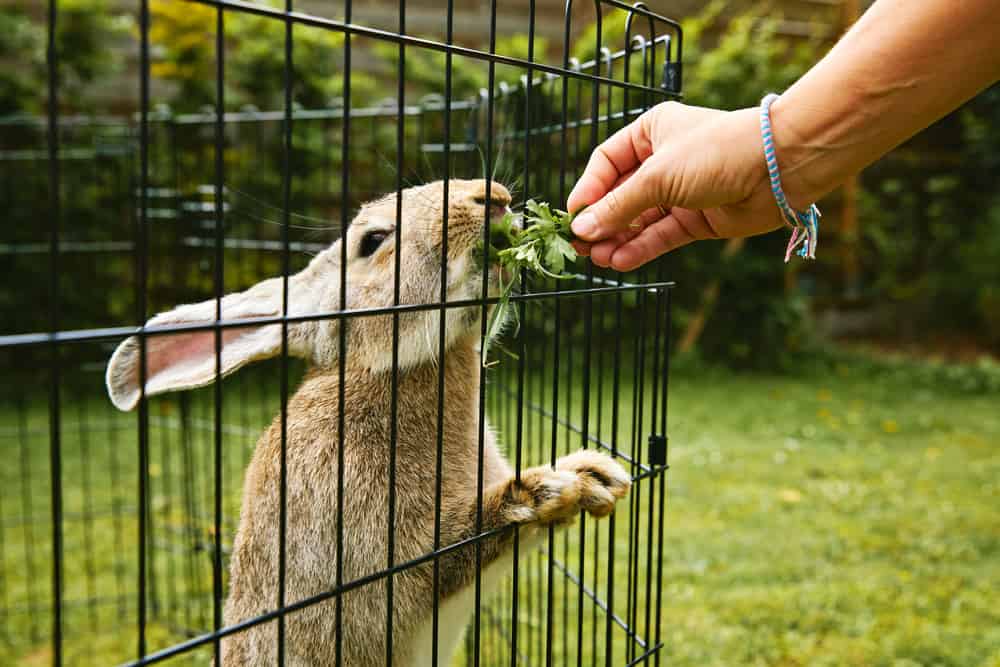
Your rabbit must get the right nutrients and environment.
©mariesacha/Shutterstock.com
Rabbits shed more when their basic requirements aren’t met. It’s important to make sure your rabbit receives plenty of food, water, and exercise as well as a proper habitat. This not only improves their shedding but makes for a healthier and happier rabbit.
Proper Diet
First and foremost, you need to make sure your rabbit has a never-ending supply of hay. No matter how large or small your rabbit is, they need hay constantly. This should make up most of their diet. You can also take them outside and let them nibble on fresh grass occasionally.
In addition to hay, they need a few vegetables and pellets each day. Focus on green, leafy vegetables like watercress, basil, cilantro, mustard greens, and carrot tops. For pellets, you want to make sure the brand has limited fillers and plenty of vitamins. A few treats here and there are also fine, so long as you do not give them foods too high in calories and carbs.
A rabbit with plenty of healthy food options has a healthier gut and the nutrients they need to maintain a silky and soft coat.
Habitat
There are a few things your rabbit needs for the perfect habitat. First off, you need to make sure your rabbit has a large enough cage. While those cheap hutches at the pet store are nice, they shouldn’t make up the entirety of your rabbit’s home. The bare minimum for a rabbit cage, for small rabbits, is four feet long by two feet wide, by four feet tall. With a cage this small, they will need to be let out a lot to stretch out and exercise.
Your rabbit needs access to toys, water, and food in their enclosure. They also need places to explore and hide. Outside, these areas can be loose dirt and tall grass. Homemade boxes and hiding holes are also helpful. Inside, you can use blankets, boxes, and beds.
Having a place to hide and ways to vent their stress helps to keep your rabbit happy and healthy. Instead of plucking out their fur, they will go and hide until they can calm down. Try to put their enclosure somewhere a little quieter with less foot traffic throughout the day.
You also want to avoid harsh flooring for your cage or area. Make sure the bottom is textured so that your rabbit doesn’t slip and hurt themselves. You also need to avoid wire-bottom cages that can severely hurt your rabbit and lead to bald patches.
Deep cleaning and litter box changing only have to be done once or twice a week. If your litter box or whatever your rabbit uses starts looking wet and smelling strongly of ammonia, you may have to change the litter box early. Otherwise, your rabbit may get urine burns that cause fur loss.
Exercise
Exercise is another great way to reduce stress and boredom in your rabbit. Try to give your pet plenty of space to jump around and play. If you can’t make their enclosure big enough, spend a few hours a day letting them run around outside or in a larger area of their home. Include toys in this area, as well as rugs, ramps, and boxes for them to climb and play on.
Rabbits need at least four hours of exercise a day. While they can do some of this in their enclosure if it’s big enough, a separate play area gives them a healthy mix of mental and physical exercise as they can spend some time exploring and smelling out the space during every visit.
The photo featured at the top of this post is © Irina Skalskaya/Shutterstock.com
Thank you for reading! Have some feedback for us? Contact the AZ Animals editorial team.



